雅思g类阅读模拟题分享
- 格式:docx
- 大小:26.79 KB
- 文档页数:11
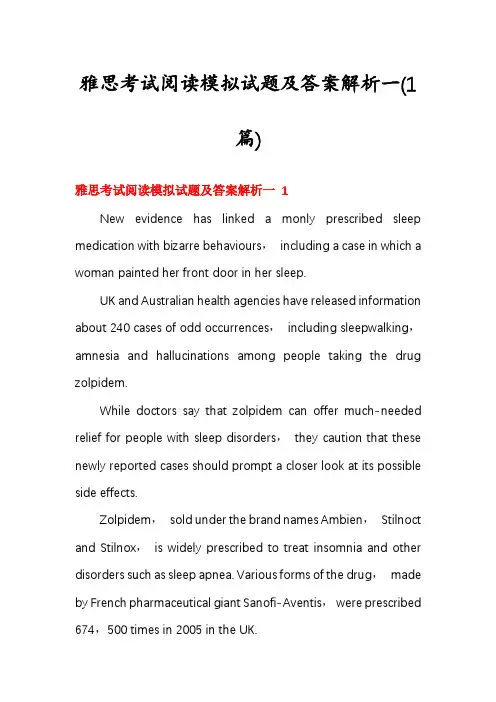
雅思考试阅读模拟试题及答案解析一(1篇)雅思考试阅读模拟试题及答案解析一 1New evidence has linked a monly prescribed sleep medication with bizarre behaviours,including a case in which a woman painted her front door in her sleep.UK and Australian health agencies have released information about 240 cases of odd occurrences,including sleepwalking,amnesia and hallucinations among people taking the drug zolpidem.While doctors say that zolpidem can offer much-needed relief for people with sleep disorders,they caution that these newly reported cases should prompt a closer look at its possible side effects.Zolpidem,sold under the brand names Ambien,Stilnoct and Stilnox,is widely prescribed to treat insomnia and other disorders such as sleep apnea. Various forms of the drug,made by French pharmaceutical giant Sanofi-Aventis,were prescribed 674,500 times in 2005 in the UK.A newly published report from Australia’s Federal Health Department describes 104 cases of hallucinations and 62 cases of amnesia experienced by people taking zolpidem since marketing of the drug began there in 2000. The health department report also mentioned 16 cases of strangesleepwalking by people taking the medication.Midnight snackIn one of these sleepwalking cases a patient woke with a paintbrush in her hand after painting the front door to her house. Another case involved a woman who gained 23 kilograms over seven months while taking zolpidem. “It was only when she was discovered in front of an open refrigerator while asleep that the problem was resolved,” according to the re port.The UK’s Medicines and Healthcare products Regulatory Agency,meanwhile,has recorded 68 cases of adverse reactions to zolpidem from 2001 to 2005.The newly reported cases in the UK and Australia add to a growing list of bizarre sleepwalking episodes linked to the drug in other countries,including reports of people sleep-driving while on the medication. In one case,a transatlantic flight had to be diverted after a passenger caused havoc after takingzolpidem.Hypnotic effectsThere is no biological pathway that has been proven to connect zolpidem with these behaviours. The drug is a benzodiazepine-like hypnotic that promotes deep sleep by interacting with brain receptors for a chemical called gamma-aminobutyric acid. While parts of the brain e less active during deep sleep,the body can still move,making sleepwalking a possibility.The product information for prescribers advises that psychiatric adverse effects,including hallucinations,sleepwalking and nightmares,are more likely in the elderly,and treatment should be stopped if they occur.Patient advocacy groups say they would like government health agencies and drug panies to take a closer look at the possible risks associated with sleep medicines. They stress that strange sleepwalking and sleep-driving behaviours can have risky consequences.“When people do something in which they’re not in full control it’s always a danger,” says Vera Sharav of the New York-based Alliance for Human Research Protection,a US networkthat advocates responsible and ethical medical research practices.Tried and tested“The more reports that e out about the potential side effects of the drug,the more research needs to be done to understand if these are real side effects,” says sle ep researcher Kenneth Wright at the University of Colorado in Boulder,US.Millions of people have taken the drug without experiencing any strange side effects,points out Richard Millman at Brown Medical School,director of the Sleep Disorders Center of Lifespan Hospitals in Providence,Rhode Island,US. He says that unlike older types of sleep medications,zolpidem does not carry as great a risk of addiction.And Wright notes that some of the reports of “sleep-driving” linked to zolpidem can be easily explained:some patients have wrongly taken the drug right before leaving work in hopes that the medicine will kick in by the time they reach home. Doctors stress that the medication should be taken just before going to bed.The US Food Drug Administration says it is continuing to “actively investigate" and collect information about cases linking zolpidem to unusual side effects.The Ambien label currently lists strange behaviour as a “special concern” for people taking the drug. “It’s a possi ble rare adverse event,” says Sanofi-Aventis spokesperson Melissa Feltmann,adding that the strange sleepwalking behaviours “may not necessarily be caused by the drug” but instead result from an underlying disorder. She says that “the safety profile [of zo lpidem] is well established”. The drug received approval in the US in 1993.Questions 1-6Do the following statements agree with the information given in the reading passage?In boxes 1-6 on your answer sheet writeTRUE if the statement is true according to the passageFALSE if the statement is false according to the passageNOT GIVEN if the information is not given in the passage1. Ambien,Stilnoct and Stilnox are brand names of one same drug treating insomnia.2. The woman’s obesity problem wasn’t resolved until she stopped taking zolpidem.3. Zolpidem received approval in the UK in 2001.4. The bizarre behaviour of a passenger after taking zolpidem resulted in the diversion of a flight bound for the otherside of the Atlantic.5. Zolpidem is the only sleep medication that doesn’t cause addiction.6. The sleep-driving occurrence resulted from the wrong use of zolpidem by an office worker.Question 7-9Choose the appropriate letters A-D and Write them in boxes 7-9 on your answer sheet.7. How many cases of bizarre behaviours are described in an official report from Australia?A. 68B. 104C. 182D. 2408. Which of the following is NOT mentioned in the product information about zolpidem?A. Treatment should be stopped if side effects occur.B. Medication should be taken just before going to bed.C. Adverse effects are more likely in the elderly.D. Side effects include nightmares,hallucinations and sleepwalking.9. Who claimed that the safety description of zolpidem waswell established?A. Kenneth WrightB. Melissa FeltmannC. Richard MillmanD. Vera SharavQuestions 10-13Answer the following questions with NO MORE THAN THREE WORDS each in boxes 10-13.10. How many times was French-made zolpidem prescribed in 2005 in Britain?11. What kind of hypnotic is zolpidem as a drug which promotes deep sleep in patients?12. What can sleepwalking and sleep-driving behaviours cause according to patient advocacy groups?13. What US administration says that it has been investigating the cases relating zolpidem to unusual side effects? Answer keys and explanations:1. TrueSee para.3 from the beginning:Zolpidem,sold under the brand names Ambien,Stilnoct and Stilnox,is widely prescribed to treat insomnia and other disorders such as sleep apnea.2. FalseSee para.1 under the subtitle “Midnight snack”:Another case involved a woman who gained 23 kilograms over seven months while taking z olpidem. “It was only when she was discovered in front of an open refrigerator while asleep that the problem was resolved”。
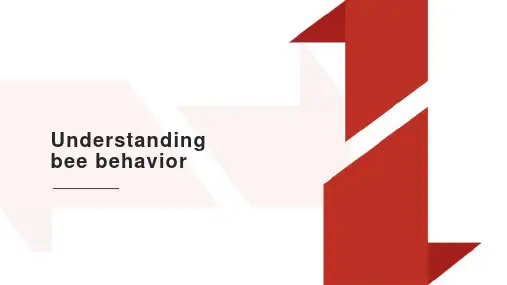
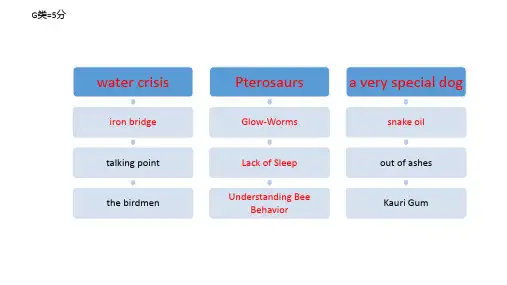
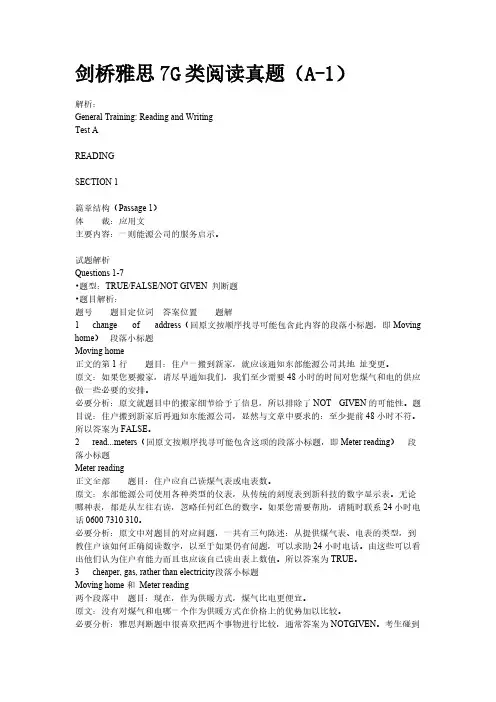
剑桥雅思7G类阅读真题(A-1)解析:General Training: Reading and WritingTest AREADINGSECTION 1篇章结构(Passage 1)体裁:应用文主要内容:一则能源公司的服务启示。
试题解析Questions 1-7•题型:TRUE/FALSE/NOT GIVEN 判断题•题目解析:题号题目定位词答案位置题解1change of address(回原文按顺序找寻可能包含此内容的段落小标题,即Moving home)段落小标题Moving home正文的第1行题目:住户一搬到新家,就应该通知东部能源公司其地址变更。
原文:如果您要搬家,请尽早通知我们,我们至少需要48小时的时间对您煤气和电的供应做一些必要的安排。
必要分析:原文就题目中的搬家细节给予了信息,所以排除了NOT GIVEN的可能性。
题目说:住户搬到新家后再通知东能源公司,显然与文章中要求的:至少提前48小时不符。
所以答案为FALSE。
2read...meters(回原文按顺序找寻可能包含这项的段落小标题,即Meter reading)段落小标题Meter reading正文全部题目:住户应自己读煤气表或电表数。
原文:东部能源公司使用各种类型的仪表,从传统的刻度表到新科技的数字显示表。
无论哪种表,都是从左往右读,忽略任何红色的数字。
如果您需要帮助,请随时联系24小时电话0600 7310 310。
必要分析:原文中对题目的对应问题,一共有三句陈述:从提供煤气表、电表的类型,到教住户该如何正确阅读数字,以至于如果仍有问题,可以求助24小时电话。
由这些可以看出他们认为住户有能力而且也应该自己读出表上数值。
所以答案为TRUE。
3cheaper, gas, rather than electricity段落小标题Moving home和Meter reading两个段落中题目:现在,作为供暖方式,煤气比电更便宜。
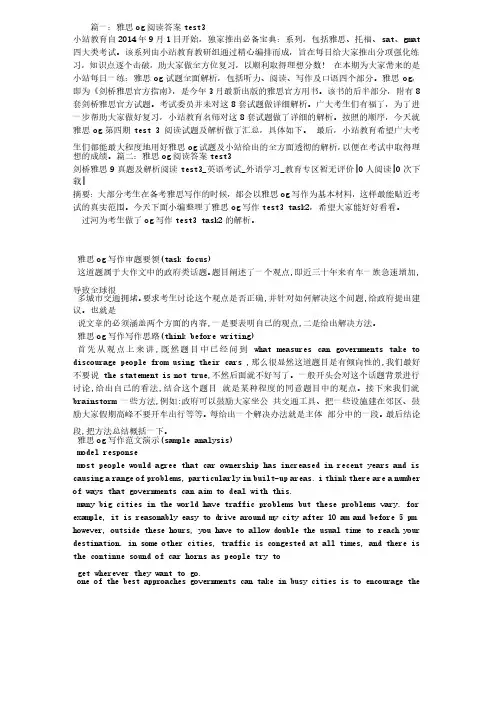
篇一:雅思og 阅读答案test3小站教育自2014年9月1日开始,独家推出必备宝典:系列,包括雅思、托福、日开始,独家推出必备宝典:系列,包括雅思、托福、sat sat sat、、gmat 四大类考试。
该系列由小站教育教研组通过精心编排而成,旨在每日给大家推出分项强化练习,习,知识点逐个击破,知识点逐个击破,知识点逐个击破,助大家做全方位复习,助大家做全方位复习,助大家做全方位复习,以顺利取得理想分数!以顺利取得理想分数!在本期为大家带来的是小站每日一练:雅思og 试题全面解析,包括听力、阅读、写作及口语四个部分。
雅思og og,,即为《剑桥雅思官方指南》,是今年3月最新出版的雅思官方用书。
该书的后半部分,附有8套剑桥雅思官方试题。
考试委员并未对这8套试题做详细解析。
广大考生们有福了,为了进一步帮助大家做好复习,小站教育名师对这8套试题做了详细的解析。
按照的顺序,今天就雅思og 第四期test 3 test 3 阅读试题及解析做了汇总,具体如下。
阅读试题及解析做了汇总,具体如下。
最后,小站教育希望广大考生们都能最大程度地用好雅思og 试题及小站给出的全方面透彻的解析,以便在考试中取得理想的成绩。
篇二:雅思og 阅读答案test3剑桥雅思9真题及解析阅读test3_test3_英语考试英语考试英语考试__外语学习外语学习__教育专区暂无评价教育专区暂无评价|0|0人阅读人阅读|0|0次下载|摘要:大部分考生在备考雅思写作的时候,大部分考生在备考雅思写作的时候,都会以雅思都会以雅思og 写作为基本材料,这样最能贴近考试的真实范围。
今天下面小编整理了雅思og 写作test3 task2test3 task2,希望大家能好好看看。
,希望大家能好好看看。
过河为考生做了og 写作test3 task2的解析。
雅思og 写作审题要领写作审题要领(task focus) (task focus)这道题属于大作文中的政府类话题。
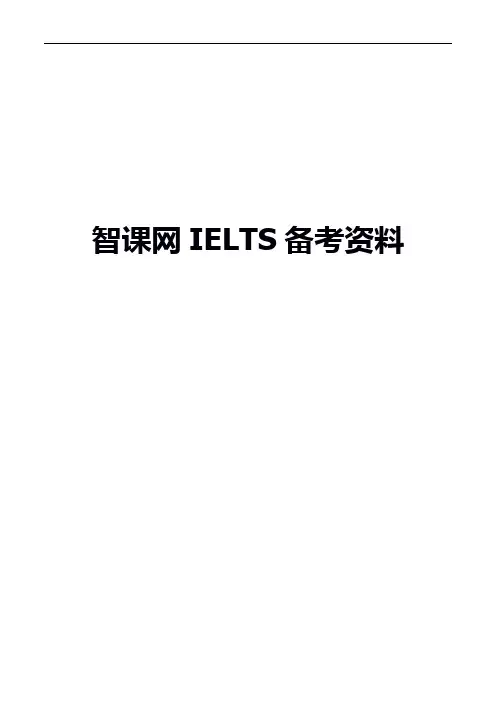
智课网IELTS备考资料剑桥雅思8G类阅读真题(B-3)摘要:在历年的雅思考试当中,剑桥雅思G类阅读真题出现的频率非常高,小编特此为雅思考生带来了剑桥雅思G类阅读真题,希望能给大家带来帮助。
参考解析:Section 3篇章结构体裁:说明文主要内容:这篇文章首先介绍了在新西兰学习第二语言没有得到普遍认同这一现象,接着从专家的角度证明学习第二语言对孩子的发展是有好处的,并以几个移民家庭的孩子为例加以说明。
试题解析Questions 28-31·题目类型:TRUE/FALSE/NOT GIVEN·题目解析:题号:28定位词:second language, born答案位置:第1段第2~3句:...in New Zealand...speakers of two or more languages are in the minority. Eighty-four percent of New Zealanders are monolingual...题解:题目:在新西兰大多数会说第二语言的人都是在别的国家出生的。
原文:……在新西兰会说两种或两种以上语言的人很少。
84%的新西兰人只会说一种语言……必要分析:题目中说在新西兰会说两种语言的人大都是外来移民。
原文中说84%的新西兰人都只会说一种语言,那么很显然在新西兰能够说两种语言的人大多数都是外来移民。
题目与原文论述一致。
答案为TRUE。
题号:29定位词:New Zealanders, good, second language答案位置:第3段第1句:But in fact, the general agreement among experts is that learning a second language is good for children.第2段最后1句:But, if you speak another language to your children in New Zealand, there are some people who think that you are not helping them to become a member of society.题解:题目:大多数新西兰人认为教孩子学第二语言是件好事。
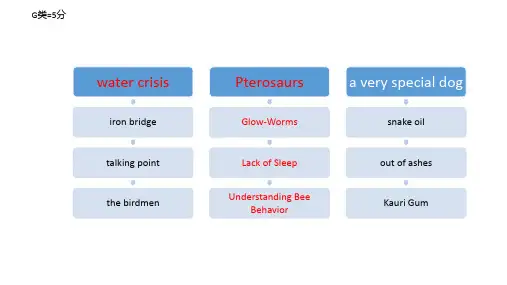

雅思阅读模拟试题及参考答案雅思阅读模拟试题 Section 1Passage 1: 旅游业的兴起阅读以下段落,回答问题。
旅游业已成为全球最大的产业之一。
每年有数亿人次的国际旅行,产生了数百万个工作岗位,并为国家经济做出了巨大贡献。
随着人们生活水平的提高和交通工具的发展,旅游业仍在不断增长。
然而,旅游业的发展也带来了一些问题,如环境污染、文化冲突和生态破坏。
Question 1: 旅游业的全球影响是什么?{content}Question 2: 旅游业发展最快的因素是什么?{content}Passage 2: 保护野生动物阅读以下段落,回答问题。
保护野生动物已成为全球关注的焦点。
然而,许多野生动物正面临生存威胁,如非法狩猎、栖息地丧失和气候变化。
为了保护这些动物,各国政府和国际组织已经采取了一系列措施,如设立自然保护区、加强法律法规和提高公众意识。
Question 3: 为什么保护野生动物变得重要?{content}Question 4: 保护野生动物采取了哪些措施?{content}雅思阅读模拟试题 Section 2Passage 1: 太阳能的未来阅读以下段落,回答问题。
太阳能是一种清洁、可再生的能源,有巨大的潜力。
随着技术的进步,太阳能电池的效率不断提高,成本也在逐渐降低。
许多国家已经开始建设太阳能发电站,以减少对化石燃料的依赖并应对气候变化。
预计未来太阳能将成为全球主要的能源来源之一。
Question 5: 太阳能的优势是什么?{content}Question 6: 为什么太阳能电池的效率不断提高?{content}Passage 2: 数字鸿沟阅读以下段落,回答问题。
数字鸿沟是指信息技术在不同群体之间的差距。
这种差距可能源于经济、教育和地理等因素。
数字鸿沟可能导致社会不平等,限制人们的发展机会。
为了解决这一问题,政府和社会组织正在努力提供更多的信息技术培训和教育,以提高人们的数字素养。
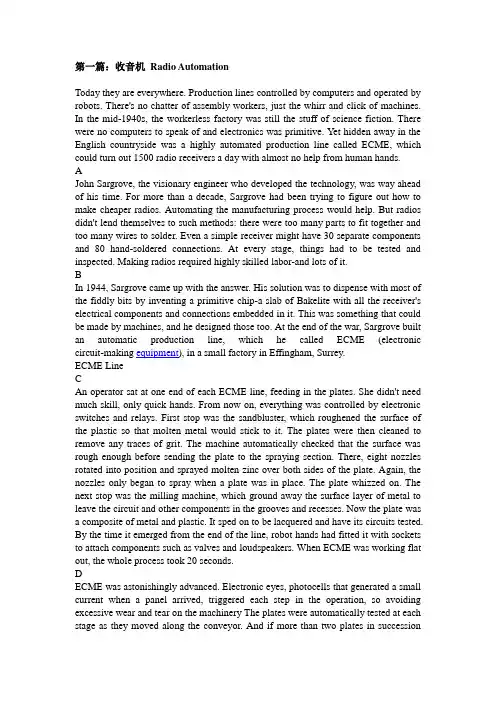
第一篇:收音机Radio AutomationToday they are everywhere. Production lines controlled by computers and operated by robots. There's no chatter of assembly workers, just the whirr and click of machines. In the mid-1940s, the workerless factory was still the stuff of science fiction. There were no computers to speak of and electronics was primitive. Yet hidden away in the English countryside was a highly automated production line called ECME, which could turn out 1500 radio receivers a day with almost no help from human hands.AJohn Sargrove, the visionary engineer who developed the technology, was way ahead of his time. For more than a decade, Sargrove had been trying to figure out how to make cheaper radios. Automating the manufacturing process would help. But radios didn't lend themselves to such methods: there were too many parts to fit together and too many wires to solder. Even a simple receiver might have 30 separate components and 80 hand-soldered connections. At every stage, things had to be tested and inspected. Making radios required highly skilled labor-and lots of it.BIn 1944, Sargrove came up with the answer. His solution was to dispense with most of the fiddly bits by inventing a primitive chip-a slab of Bakelite with all the receiver's electrical components and connections embedded in it. This was something that could be made by machines, and he designed those too. At the end of the war, Sargrove built an automatic production line, which he called ECME (electronic circuit-making equipment), in a small factory in Effingham, Surrey.ECME LineCAn operator sat at one end of each ECME line, feeding in the plates. She didn't need much skill, only quick hands. From now on, everything was controlled by electronic switches and relays. First stop was the sandbluster, which roughened the surface of the plastic so that molten metal would stick to it. The plates were then cleaned to remove any traces of grit. The machine automatically checked that the surface was rough enough before sending the plate to the spraying section. There, eight nozzles rotated into position and sprayed molten zinc over both sides of the plate. Again, the nozzles only began to spray when a plate was in place. The plate whizzed on. The next stop was the milling machine, which ground away the surface layer of metal to leave the circuit and other components in the grooves and recesses. Now the plate was a composite of metal and plastic. It sped on to be lacquered and have its circuits tested. By the time it emerged from the end of the line, robot hands had fitted it with sockets to attach components such as valves and loudspeakers. When ECME was working flat out, the whole process took 20 seconds.DECME was astonishingly advanced. Electronic eyes, photocells that generated a small current when a panel arrived, triggered each step in the operation, so avoiding excessive wear and tear on the machinery The plates were automatically tested at each stage as they moved along the conveyor. And if more than two plates in successionwere duds, the machines were automatically adjusted-or If necessary halted. In a conventional factory, workers would test faulty- circuits and repair them. But Sargrove's assembly line produced circuits so cheaply they Just threw away the faulty ones. Sargrove's circuit board was even more astonishing for the time. It predated the more familiar printed circuit, with wiring printed on aboard, yet was more sophisticated. Its built-in components made it more like a modem chip.EWhen Sargrove unveiled his invention at a meeting of the British Institution of Radio Engineers in February 1947, the assembled engineers were impressed. So was the man from The Times. ECME, he reported the following day, "produces almost without human labour, a complete radio receiving set. This new method of production can be equally well applied to television and other forms of electronic apparatus."FThe receivers had many advantages over their predecessors. Wit components they were more robust. Robots didn't make the sorts of mistakes human assembly workers sometimes did. "Wiring mistakes just cannot happen/ wrote Sargrove. No wires also meant the radios were lighter and cheaper to ship abroad. And with no soldered wires to come unstuck, the radios were more reliable. Sargrove pointed out that the circuit boards didn't have to be flat. They could be curved, opening up the prospect of building the electronics into the cabinet of Bakelite radios.GSargrove was all for introducing this type of automation to other products. It could be used to make more complex electronic equipment than radios, he argued. And even if only part of a manufacturing process were automated, the savings would be substantial. But while his invention was brilliant, his timing was bad. ECME was too advanced for its own good. It was only competitive on huge production runs because each new job meant retooling the machines. But disruption was frequent. Sophisticated as it was, ECME still depended on old-fashioned electromechanical relays and valves-which failed with monotonous regularity. The state of Britain's economy added to Sargrove's troubles. Production was dogged by power cuts and post-war shortages of materials. Sargrove's financial backers began to get cold feet.HThere was another problem Sargrove hadn't foreseen. One of ECME's biggest advantages-the savings on the cost of labour-also accelerated its downfall. Sargrove's factory had two ECME production lines to produce the two circuits needed for each radio. Between them these did what a thousand assembly workers would otherwise have done. Human hands were needed only to feed the raw material in at one end and plug the valves into their sockets and fit the loudspeakers at the other. After that, the only job left was to fit the pair of Bakelite panels into a radio cabinet and check that it worked.ISargrove saw automation as the way to solve post-war labor shortages. With somewhat Utopian idealism, he imagined his new technology would free people from boring, repetitive jobs on the production line and allow them to do more interestingwork. "Don't get the idea that we are out to rob people of their jobs,' he told the Daily Mirror. “Our task is to liberate men and women from being slaves of machines."JThe workers saw things differently. They viewed automation in the same light as the everlasting light bulb or the suit that never wears out-as a threat to people's livelihoods. If automation spread, they wouldn't be released to do more exciting jobs. They'd be released to join the dole queue. Financial backing for ECME fizzled out. The money dried up. And Britain lost its lead in a technology that would transform industry just a few years later.Question 1-7SummaryThe following diagram explains the process of ECME:Complete the following chart of the paragraphs of Reading Passage, using no more than two words from the Reading Passage for each answer. Write your answers in boxes 1-7 on your answer sheet.Question 8-11SummaryComplete the following summary of the paragraphs of Reading Passage, using no more than two words from the Reading Passage for each answer. Write your answers in boxes 8-11 on your answer sheet.Sargrove had been dedicated to create a___8___radio by automation of manufacture. The old version of radio had a large number of independent___9___After this innovation made, wireless-style radios became___10___and inexpensive to export oversea. As the Sargrove saw it, the real benefit of ECME's radio was that it reduced___11___of manual work .which can be easily copied to other industries of manufacturing electronic devices.Cheaper、components、lighter、costQuestion 12-13Choose the correct letter, A, B, C or D.Write your answers in boxes 12-13 on your answer sheet.12 What were workers attitude towards ECME Model initially? AA anxiousB welcomingC boringD inspiring13 What is the main idea of this passage? CA approach to reduce the price of radioB a new generation of fully popular products and successful businessC an application of the automation in the early stageD ECME technology can be applied in many product fields篇章结构:体裁说明文题目收音机自动化---集成电路的先驱结构Paragraph 1: 在电子技术极其落后的1940s, 英国出现了收音机自动化生产线---ECME.A段:收音机并不特别适合用自动化流程生产。


智课网IELTS备考资料剑桥雅思7G类阅读真题(B-3)摘要:每年在雅思考试当中都会出现剑桥雅思真题,多做剑桥雅思真题有利于我们更好的应对雅思考试,小编为您整理了剑桥雅思真题,有需要的同学赶快来下载吧。
剑桥雅思 G类真题参考解析:SECTION 3篇章结构体裁:说明文主要内容:介绍了艾恩布里奇铁桥的历史及其建造历程。
关于铁桥的建造方法存在不同意见,瑞典的一幅水彩画展示出了铁桥的建造方法,经过调查研究证明该方法是可行的。
文章结构:A段:简单介绍了艾恩布里奇铁桥的地理位置及历史意义。
B段:塞文河曾经的盛况,欧洲最为繁忙的河道之一。
C段:巴兹尔·布鲁克和亚伯拉罕·达比一世的贡献。
D段:亚伯拉罕·达比二世有在塞文河上建造大桥的想法,而最终由亚伯拉罕·达比三世将此想法付诸实施。
E段:铁桥的修建过程:1778-1779年冬铸造完成构件,1781年正式使用。
F段:铁桥的修建之谜,一幅水彩画的出现为铁桥的建造提供了新的解释。
G段:瑞典水彩画中对铁桥建造过程的描绘颠覆了所有历史学家先前的假设,针对水彩画中描绘的方法很多人进行了调查研究来验证其适用与否。
H段:研究结果告诉我们更多有关这座桥是如何被建造的信息。
I段:有关铁桥的故事仍有一个未解之谜。
试题解析Questions 28-31·题型:SHORT ANSWER QUESTIONS 简答题·题目解析:题号题目定位词答案位置题解28 when, the furnace, constructed C段第1行注意题目要求ONE NUMBER ONLY只能是1个数字。
题目均是由特殊疑问词when提问的,所以首先确定答案形式全都是数字,表时间或年代。
建议考生可以把全文中所有表时间、年代的数字都画出来,这样就会一目了然,缩小了寻找答案的范围。
然后利用顺序原则,细致比较原文中时间点附近的单词是否与题目中的关键词有同义替换表达,进而确定最佳答案。
雅思g类阅读模拟题分享雅思考试前要多做题才会积累经验,避免错误,下面小编给大家带来一道雅思g类阅读模拟题分享,希望喜欢。
雅思g类阅读模拟题READING PASSAGE 2You should spend about 20 minutes on Questions 15-26 which are based on Reading Passage 2 below.An examination of the functioning of the senses in cetaceans, the group of mammals comprising whales, dolphins and porpoises鲸鱼的感官鲸目动物(包括鲸、海豚、鼠海豚等晡乳动物)的感官功能测试。
Some of the senses that we and other terrestrial mammals take for granted are either reduced or absent in cetaceans or fail to function well in water. For example, it appears from their brain structure thattoothed species are unable to smell. Baleen species, on the other hand, appear to have some related brain structures but it is not known whether these are functional. It has been speculated that, as the blowholes evolved and migrated to the top of the head, theneural pathways serving sense of smell may have been nearly all sacrificed. Similarly, although at least some cetaceans have taste buds, the nerves serving these have degenerated or arerudimentary.对我们人类以及其他的陆地哺乳动物来说,有些感官是与生俱来的,然而对于鲸鱼来讲,这些功能要么已经衰退或彻底消失,要么就无法在水中正常发挥作用。
比如说从齿鲸的大脑结构来看,它们是嗅不到气味的;而须鲸虽然有与嗅觉相关的脑部结构,可是我们却无法判断这些结构是否起作用。
据推测,由于鲸鱼的气孔进化并最终移到了头部的正中,所以掌管嗅觉的神经纤维几乎全部不见了。
同样,尽管有些鲸鱼也有味蕾,但这些味觉器官要么已经退化,要么就根本没有发育。
The sense of touch has sometimes been described as weak too, but this view is probably mistaken. Trainers of captive dolphins and small whales often remark on their animals’ responsiveness to being touched or rubbed, and both captive and freeranging cetaceanindividuals of all species (particularly adults and calves, or members of the same subgroup) appear to make frequent contact. This contact may help to maintain order within a group, and stroking or touching are part of the courtship ritual in most species. The area around the blowhole is also particularly sensitive and captiveanimals often object strongly to being touched there.有人认为鲸鱼的触觉也不发达,不过这个观点很可能是错误的。
训练人工饲养海豚和小鲸鱼的人常常会评论他们的小动物对于触碰和抚摩的敏感度。
而无论是人工饲养还是放养,几乎所有种类的鲸鱼个体之间都会进行频繁的接触,特别是在成年鲸鱼和幼鲸之间或同一亚群的成员之间。
这种接触有助于维护同一种群内部的秩序,而且对大多数鲸鱼而言,抚摸和触碰也是求偶仪式的一部分。
气孔周围的部分尤其敏感,一旦被触碰,人工饲养的鲸鱼就会有激烈的反应。
The sense of vision is developed to different degrees in different species. Baleen species studied at close quarters underwater – specifically a grey whale calf in captivity for a year, and free-ranging right whales and humpback whales studied and filmed off Argentina and Hawaii – have obviously tracked objects with vision underwater, and they can apparently see moderately well both in water and in air. However, the position of the eyes so restricts the field of vision inbaleen whales that they probably do not have stereoscopic vision.不同种类的鲸鱼,视觉发达程度也各不相同。
通过研究一只被人工饲养了一年的小灰鲸,以及通过对阿根廷和夏威夷沿海所放养的露脊鲸和座头鲸的研究及拍摄,人们发现在封闭水域中的须鲸显然可以利用视觉来追踪水下的物体,而且它们无论在水中或空气中视力都相当好。
但是眼睛的位置如此严重地限制了须鲸的视野,以致于它们可能不具备立体视觉。
On the other hand, the position of the eyes in most dolphins and porpoises suggests that they have stereoscopic vision forward and downward. Eye position in freshwater dolphins, which often swim on their side or upside down while feeding, suggests that what vision they have is stereoscopic forward and upward. By compare-son, thebottlenose dolphin has extremely keen vision in water. Judging from the way it watches and tracks airborne flying fish, it can apparently see fairly well through the air–water interface as well.And although preliminary experimental evidence suggests that their in-air vision is poor, the accuracy with which dolphins leap high to take small fish out of a trainer’s hand provides anecdotal evidence to the c ontrary.从另一方面来看,大多数海豚和江豚眼睛的位置表明它们是拥有向前及向下的立体视觉的。
淡水海豚经常侧游,或是在吃东西的时候肚皮朝上游泳,这就表明眼睛的位置使它们拥有向前及向上的立体视觉。
相反的是,宽吻海豚在水中视力就很敏锐,而从它观察及追踪空中飞鱼的方式来看,它在水天交界面的视力也相当好。
尽管之前的实验证据表明,海豚在露天环境中可能是睁眼瞎,然而,它们能够从水中跃起很髙,并且能够准确地吃到训练员手中的小鱼,这就有趣地证明了上述观点是错误的。
Such variation can no doubt be explained with reference to the habitats in which individual species have developed. For example, vision is obviously more useful to species inhabiting clear open waters than to those living in turbid rivers and flooded plains. The South American boutu and Chinese beiji, for instance,appear to have very limited vision, and the Indian susus are blind, their eyes reduced to slits that probably allow them to sense only the direction and intensity of light.当然,这些变异可以通过这些品种所生长的环境来解释。
比如说,对于宽广清澈水域中的鲸鱼来说,视觉显然就有用的多;而对于那些住在混浊的河流或水淹的平原上的品种来说,视力显然就没什么大用。
比如,南美洲亚马逊河中的江豚以及中国的白鳍啄视力都相当有限,而印度河中的江豚根本看不见东西,它们的眼睛已经退化成了两条窄缝,除了感知一下方向和光的强度几乎没什么作用。
Although the senses of taste and smell appear to have deteriorated, and vision in water appears to be uncertain, such weaknesses are more than compensated for by cetaceans’ well-developed acousticsense. Most species are highly vocal, although they vary in the range of sounds they produce, and many forage for food using echo-location_ Large baleen whales primarily use the lower frequencies and are often limited in their repertoire. Notable exceptions are the nearly song-like choruses of bowhead whales in summer and the complex, haunting utterances of the humpback whales. Toothedspecies in general employ more of the frequency spectrum, and produce a wider variety of sounds, than baleen species (though the sperm whale apparently produces a monotonous series of high-energy clicks and little else). Some of the more complicated sounds are clearly communicative, although what role they may play in the social life and ‘culture’ of cetaceans has been more the subject of wild speculation than of solid science.尽管鲸鱼们的味觉和嗅觉严重衰退,在水中的视觉又不那么确定,然而这些缺陷完全可以被它们那高度发迖的听觉系统所弥补。